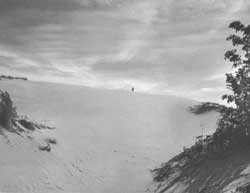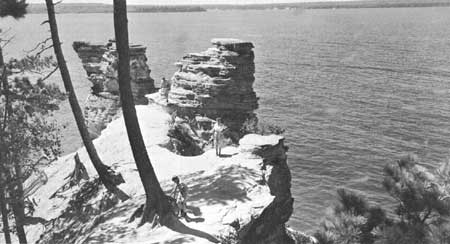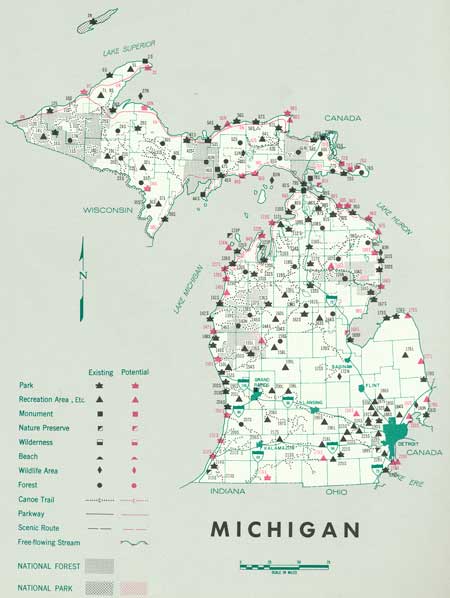.gif)
Parks for America
MENU
|
Parks for America
|

|
MICHIGAN
MICHIGAN, fronting on four of the Great Lakes, has varied and abundant resources for outdoor recreation.

|
| The sands of Thunder Mountain dwarf a solitary tramper. The high dunes, beaches and woodlands of the area merit State protection. |
In the decade 1950-60, Michigan experienced a population growth of almost 1.5 million. In 1960, over 73 percent of the population was urban, an increase of about 27 percent during the past decade. Density ranges from 4 per square mile in Keweenaw County on the Upper Peninsula to 4,393 per square mile in Wayne County. There are 10 metropolitan areas in the State. Projections indicate that the State population will increase from 7,823,194 in 1960 to 11,615,000 by 1976.
The tourist-vacation industry ranks with manufacturing and agriculture as one of the State's three most important income sources. It brought an estimated $650 million into the State in 1960, placing Michigan fourth among all States for vacation popularity. Some 10 million people vacation in Michigan each year, with about half this number coming from out of State.
The Interstate Highway System, as proposed, will speed travel from the urban centers in the southern portion of the State to the recreation resources in the northern portion of the Lower Peninsula and the east and central portions of the Upper Peninsula.
The Upper Peninsula and the northern half of the Lower Peninsula are, for the most part, forest covered (including approximately 6.3 million acres of National and State forests), with thousands of lakes and ponds dotting the landscape. The State is one of the most popular hunting and fishing regions in the United States. Lakes and streams also occur in large numbers even in the densely populated southern portion of the State. The varied climate is conducive to year-round outdoor activities. All types of winter sports are popular, both with residents and out-of-State vacationers.
Archeological sites are numerous though not often highly dramatic. There are many historic sites associated with French exploration, the fur trade, and the economic evolution of the State. Many of these have been marked and a few are preserved in State parks. Fort Michilimackinac, St. Ignace Mission, and Mackinac Island possess exceptional value in commemorating the history of the United States.
EXISTING PUBLIC AREAS
NATIONAL: The National Park Service administers one national park of 539,339 acres. Visits in 1960 amounted to 6,000. Five national forests totaling 2,553,703 acres, including 65 developed recreation areas, are administered by the Forest Service. The Bureau of Sport Fisheries and Wildlife administers five national wildlife refuges of 104,296 acres.
STATE: The Parks and Recreation Division administers 73 park and recreation areas totaling 182,541 acres, and 4 historic sites with a total of 2,567 acres. Combined 1960 visits were 18,144,900. Twenty-three forests totaling 3,765,468 acres, including 105 developed recreation areas, are administered by the Forestry Division. The Game Division administers 57 game areas with a combined acreage of 197,391 and some 672 fishing access sites. Approximately 118 roadside rest areas are under the Highway Department.
LOCAL: Local park authorities administer over 19,621 acres in some 114 nonurban parks. One historic monument is also in local public ownership.
QUASI-PUBLIC AND PRIVATE: There are two island natural preserves, containing 21S acres, and one historic monument.
PRIVATE ENTERPRISE: Private recreation facilities and services are extremely important. The vast majority of tourist services and facilities such as cabins, boat rentals, and guide services are provided by private enterprise.
PARK AND RELATED NEEDS
The shoreline of Michigan should be the object of an extensive acquisition program of areas worthy of protection for public recreation use. Also, there is urgent need for acquisition of other lands, particularly in the southern half of the State, to preserve open space and provide outdoor recreation opportunities for urban dwellers. Bond issues are helping Michigan's park acquisition and development program.
Existing State park and recreation areas now provide approximately half of the acreage considered desirable for a population nearing 8 million. Potential areas of State significance identified in this plan total 118,417 acres. Other areas should be selected and developed to provide a well-distributed and adequate State system by 1976. Equally urgent is the need for additional local parks in urban areas. This plan identifies 3,050 acres as suitable for this purpose. More will be needed by 1976.

|
| A family visits Miners Castle, at the spectacular Pictured Rocks of Northern Michigan. This region of cliffs, beaches, dunes, woodlands, lakes and waterfalls has been proposed as a natural lakeshore. |
RECOMMENDATIONS
Existing recreation resources and many potential areas are shown on the accompanying tabulation and map. If the following recommendations can be vigorously carried out by the agencies concerned, they may help to provide important additional outdoor recreation opportunities in Michigan.
NATIONAL: Establishment of the Sleeping Bear and Pictured Rocks areas as units of the National Park System. Legislation to effect this has been introduced. Studies to determine the desirability and feasibility of providing future national protection for the Huron Mountains area, and of a Lake Superior Shoreline Parkway.
STATE: Expansion of the State park system by the addition of 12 parks, 2 recreation areas, and 2 historic sites. Further study of 16 other areas as possible additions to the system is suggested. Major land additions to 36 existing park and recreation areas should be considered.
Designation and protection of four scenic roads and two free-flowing streams from objectionable encroachments by acquiring easements or by acquisition of bordering lands.
Public lands exhibiting wilderness characteristics should be located and permanently retained as nature preserves. Two potential nature preserves and one wilderness area are identified for additional study.
LOCAL: Local park and recreation systems are in adequate to the needs of the population. Consideration should be given to the acquisition of open space at the local, county, and metropolitan levels. Enabling legislation may be necessary. Three parks and one recreation area should be acquired and further study made of one recreation area.
Supporting recommendations include
1. Study of the recreation potential of existing State forests and initiation of a development program for potential public use areas.
2. Provision for additional marinas, docking space, shoreline campgrounds and other water-related facilities.
3. A comprehensive survey of archeologic and historic sites within the State should be conducted with a view to the preservation and development of those found to possess significant educational and inspirational values.
4. Protection of free-flowing streams and important lakeshore lands by scenic easements or outright purchase.
(Table omitted from online edition)

|
| (click on image for an enlargement in a new window) |
NEXT >>>
|
|
Last Modified: Mon, Sep 6 2004 10:00:00 pm PDT
parks_america/michigan.htm
 Top
Top